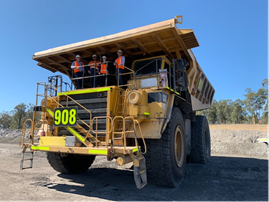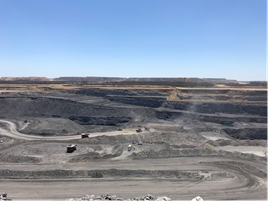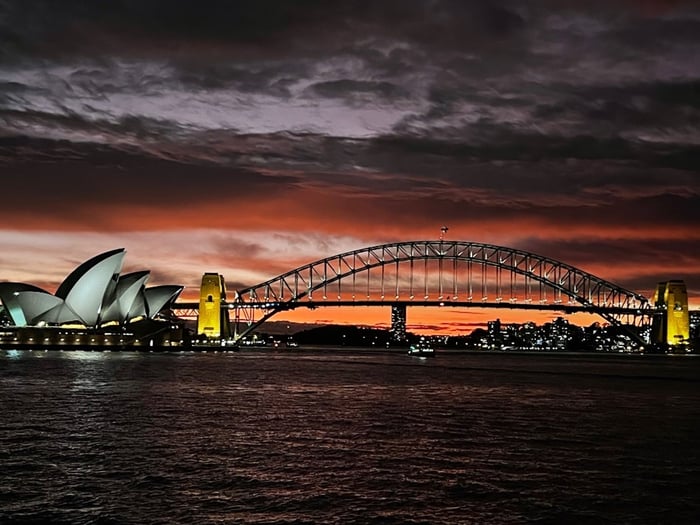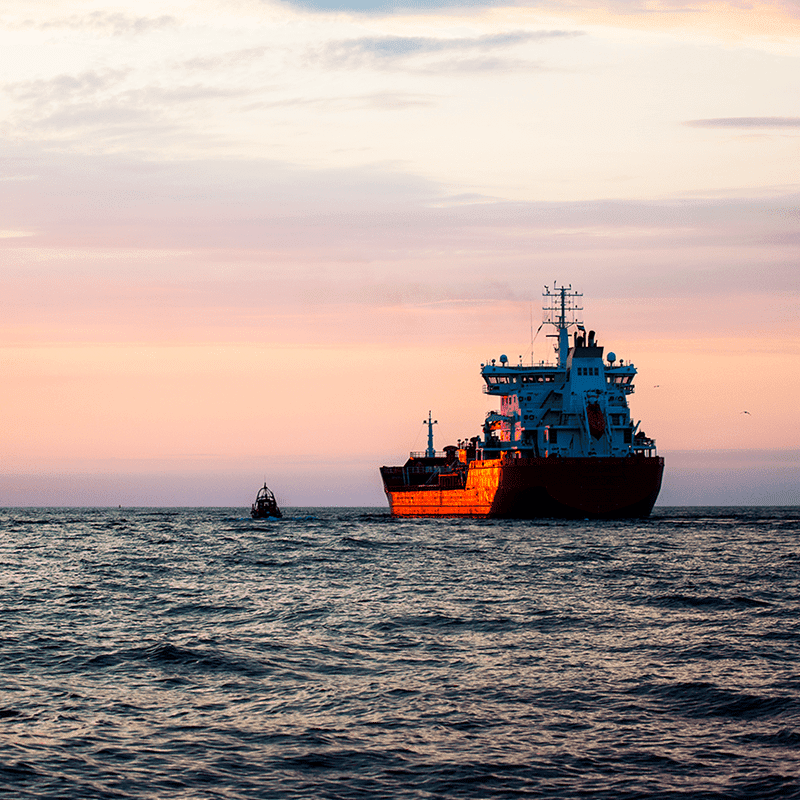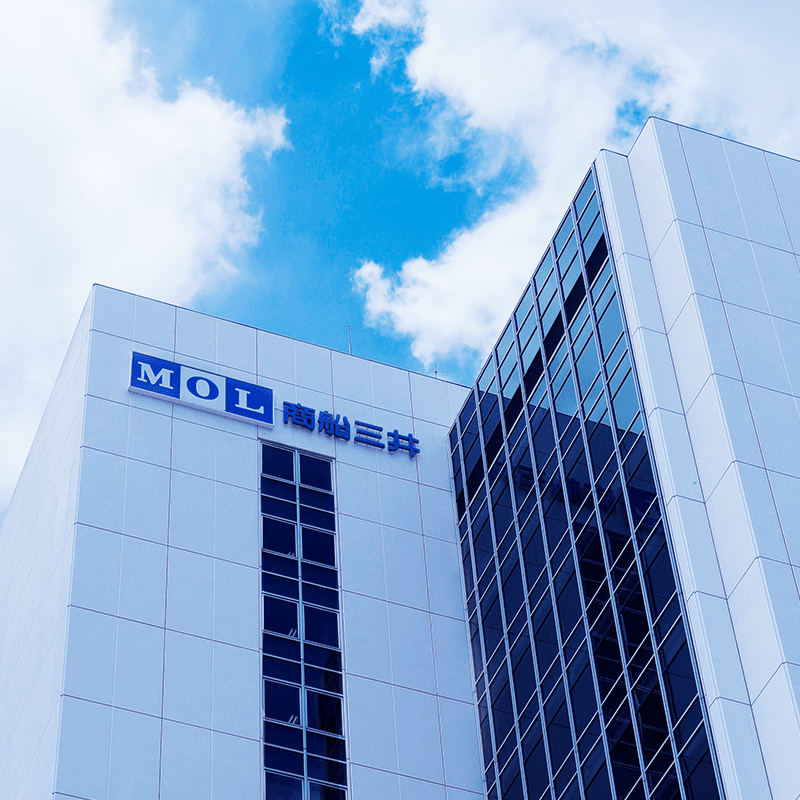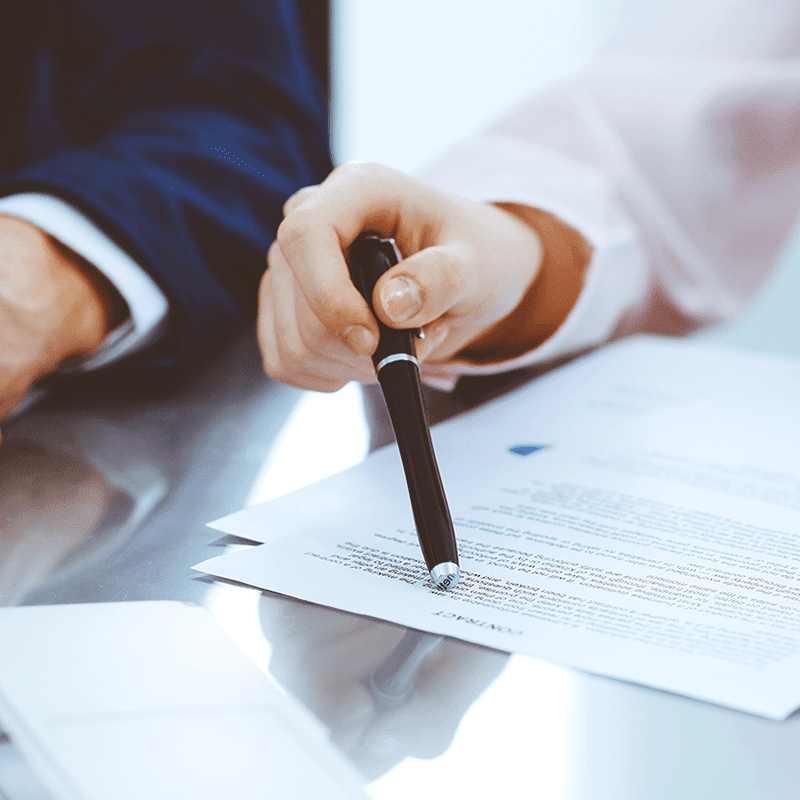BLOG
Now in Australia ~Interview with MOL Australia~
- General Shipping
2022.08.10
Vast land and abundant resources with optimal conditions for renewable energy
Before we start talking about Australia, I would first like to talk about the differences in scale between Australia and Japan. Australia is the sixth largest country in the world in terms of land area, with 7.69 million km2, where about 25.75 million people (as of September 2021) live. It has a population of about 1/5 that of Japan, although its land area is 20 times larger. Deserts, are prevalent inland and the population is disproportionately concentrated in coastal areas, where the population density is far lower than that of Japan. It is also rich in resources such as coal, iron ore, and LNG, and exports these resources to China, Japan, South Korea, and many other countries around the world.
The vast land space and abundant resources has also had a significant impact on energy management. For example, in Japan, to install solar panels, a mountain needs to be cut down to create an installation surface, or solar panels are installed on the roof of houses. In Australia, on the other hand, they have large flat land areas, so there is no shortage of places to install solar panels. Taking advantage of the best conditions for generating renewable energy, Australia is actively adopting solar power, hydropower, wind power, and offshore wind power, and has announced that all electricity in the country will shift to renewable energy by 2032.
There has also been a lot of discussion about nuclear power, but there has never been a nuclear power plant in the history of the country as the majority of people believe that no nuclear power plants should be built if nuclear waste cannot be safely and harmlessly disposed of. Therefore, although it has the world’s largest uranium reserves, it does not use it as a fuel for its own nuclear power plants but rather exports it to other countries.
Australia's abundant resources are exported to various countries worldwide. Our main job at MOL is to assist in the transportation of those resources from Australia to various other countries by ship, and to transport automobiles and other products into Australia. However, we do more than simply transport resources and products, we also work for renewable energy to help towards creating a decarbonized society. In this blog, we interview Mr. Hideyuki Irisawa, our chief country representative in Australia, to find out more about the initiatives in Australia.
Activities to connect demand and supply for hydrogen and ammonia in the future
--What specific initiatives are you working on in Australia?Coal, Ores, and LNG are currently Australia's three main exports. In addition, Australia's industry, government and academia are working together to develop the hydrogen and ammonia industry as the world moves towards a decarbonized society. Ammonia has been used in the past as a basic material for agricultural fertilizers and chemicals, but it is now attracting attention for its great potential as a next-generation energy source. Ammonia is a carbon-free material that emits no CO2 when burnt and is easy to liquefy, making it suitable for transportation. Currently, attempts are being made to mix it with coal and used it in thermal power generation to reduce CO2 emissions, but research is underway to only use ammonia for power generation as an energy source in the future.//Reference//
Related blog:Ammonia in the Spotlight: Five Things to KnowHydrogen, which has a high affinity with ammonia, is also becoming increasingly valuable for use. Hydrogen is essential for the production of ammonia and is considered "essential for carbon neutrality," which contributes to the decarbonization of the power and industrial sectors, etc. There is an increasing demand for hydrogen worldwide along with ammonia.
According to the Australian Renewable Energy Agency (ARENA), Australia's hydrogen and ammonia exports are expected to reach around AUD 5.7 billion (about 520 billion yen) by 2040. There are currently more than 100 hydrogen and ammonia-related projects that have been publicly announced, with some of them aiming to begin exporting by the late 2020s. In response, MOL is approaching several major energy companies in Australia to connect the supply and demand ends for hydrogen and ammonia, and we are working to strengthen relationships that will lead to increase maritime transportation of these resources from Australia.
//Reference//
ARENA Projects:https://arena.gov.au/projects/?project-value-start=0&project-value-end=200000000&technology=hydrogen&page=3
Becoming a Green Energy Great Power with Renewable Energy Resources
--Australia is rapidly expanding into renewable energy, but are there any challenges?
In Australia, environmental awareness has increased to the point that marine biosecurity regulations have been imposed by the Department of Agriculture, Fisheries and Forestry to ensure that transport vessels do not pollute local waters with contaminated ballast water or by marine pests, thereby protecting agricultural and marine ecosystems. Regarding decarbonization, an announcement by the new Labor Party, which took office in May 2022, raised the previous government's target for greenhouse gas emission reductions (comparing 2005 with 2030) from 28% to 43%. Furthermore, they aim to achieve net zero emissions by 2050. For this reason, the entire nation is focusing on the production of 'green hydrogen' and 'green ammonia,' using renewable energy sources to produce them, aiming to become a "green energy great power".
--One of the key industries in Australia is the coal industry, what are your thoughts on the prospects and challenges ahead?
The coal industry remains a major industry, but it is heading in a different direction from the transformation to a decarbonized society. Coal-fired power generation accounts for 60% of Australia's electricity, and Australia is trying to gradually close them down and switch to renewable energy. The big challenge is how to grow and transfer to the renewable energy sector while balancing the revenue and employment issues inherent in the coal industry.
Also, we need to have a balanced shift to renewable energy in terms of electricity supply, as well as the aforementioned revenue and employment issues. Currently, we have moved too quickly towards renewable energy, resulting in a shortage of electricity called an "energy crisis" (as of July 2022). This is why the Minister for Resources and Water in Australia has made restarting coal-fired power plants a priority. This energy crisis is due to a combination of natural phenomena such as flooding, fires, and cooler weather on the East Coast, and periodic maintenance and inspections of power facilities. However, it is a serious problem that is having a significant impact on manufacturing and other industries which consume a large amount of electricity.
Coal transport trucks at an open-pit coal mine
Collaboration with environmental organizations and government agencies is a challenge
--In some cases it is difficult to promote projects from an environmental protection point of view, what exactly has happened?
In some cases, coal mine development has been cancelled due to stricter regulations for coal power and opposition from environmental organizations, while in other cases, the construction of LNG import terminals has been reversed after lobbying by local residents and the federal government due to concerns about serious environmental damage.
The activities of environmental organizations are difficult to predict, and it can be very vexing as what is approved by the federal government can be rejected by the state government. We try to expand our network to get information on projects of interest from reliable government-affiliated organizations. We also need to see them face to face if necessary and stay close to them.//Reference//
Australian Financial Review:AGL broods on Crib Point LNG rebuff (afr.com)
An article reporting that the Victorian Government had announced it would not support AGL's plan to build an LNG import terminal at Crib Point in Victoria because of environmental concerns, following fierce opposition from local residents.
Future relationship with China
--What do you think the relationship with China will look like?
China is still Australia's largest trading partner, but in the last five years or so, I’ve realized that the political wind has shifted from reconciliation to confrontation in terms of the Uighur issue and security. The hardline policy toward China is widely acknowledged to continue. When prime minister Morrison was replaced by Albanese in May 2022, China saw the change of government as a good opportunity to try and improve relations between them. However, at the QUAD Leaders’ Tokyo Summit, the security framework of Australia,India, Japan, the United States, Albanese stated there was no immediate prospect of an improvement in relations with China. Australia's Labor government is also reviewing rights agreements with Chinese energy and infrastructure companies in Australia with the aim of terminating them sooner rather than later. Although it is not clear what the future holds, business plans for China will have to be carefully looked at and considered situation by situation.
To conclude:
Life in Australia and prospects for the future
--How do you like living in Australia?
My base is in Sydney where is the center of the Australian economy, and in the city, I've occupied in a building owned by Daibiru which is the one of MOL group companies. The head office of the local subsidiary is in Melbourne, where I also work with the 8 national staff there. We also have a representative in Perth, bringing our total number to 13, including outside directors, and customer service and sales. I go to the Melbourne head office once a month for about a week (a short business trip). The distance is about 900 km, which is a about the same distance as Tokyo to Hiroshima, so I travel by plane. I also travel to Brisbane, which is almost the same distance away, as it is a base for the coal and new energy industries. Australia is a very big country! The coastal climate is similar to Japan’s, so both Sydney and other cities are comfortable to live in, and the food is very good and matches many Japanese taste preferences. I often eat Aussie beef and lamb. Seafood is abundant and I find oysters especially tasty. Wine is also popular in many households and it is often of good quality and inexpensive. Not to be forgotten is the friendly and welcoming nature of the people, who are open to diversity. A positive attitude toward Japanese culture definitely helps us to build partnerships.
--Are the challenges ahead in Australia primarily decarbonization and renewable energy issues?
Yes. Australia is a very important country for MOL. We import a lot of resources from Australia, iron ore, coal, LNG, etc. In addition to this, we also have a large share in the automobile trade. We look forward to further growth in the area of renewable energy resources.
-- Thank you.
 Online workshops with staff from Australia and New Zealand,
Online workshops with staff from Australia and New Zealand,
discussing desirable ways of working. (held in April 2022)
 State Of Origin interstate rugby match with members of a local company.
State Of Origin interstate rugby match with members of a local company.
80,000 people gathered in the stadium and enthusiastically watched the game.
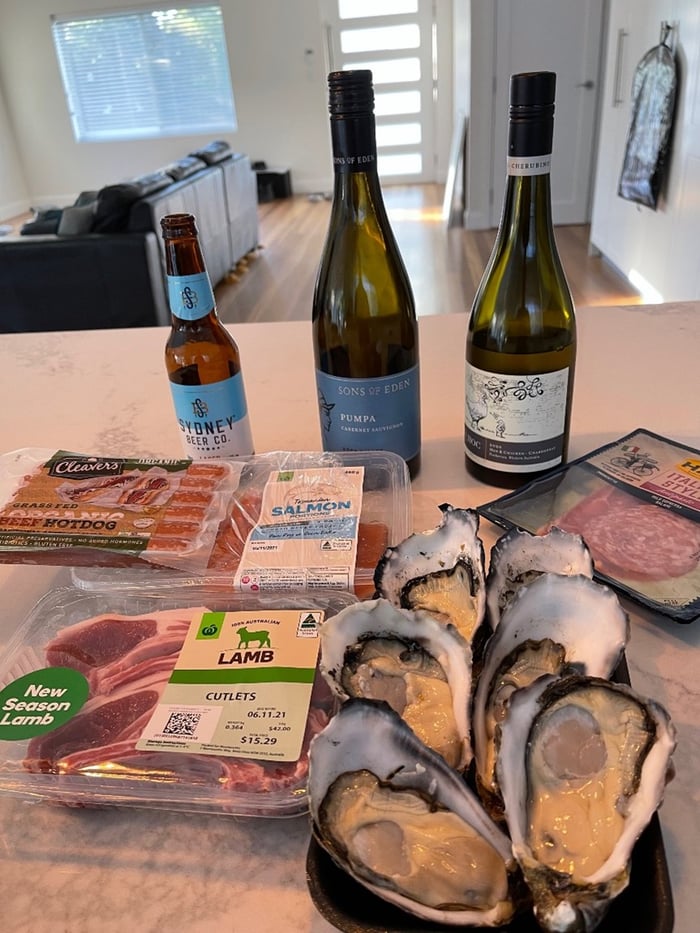
Aussie lamb, oysters, beer and wine recommended by Mr. Irisawa. These can all be purchased at a nearby supermarket. Prices have significantly increased recently.
Night View of Sydney after rain (Opera House and Harbour Bridge from the Ferry)
【Profile】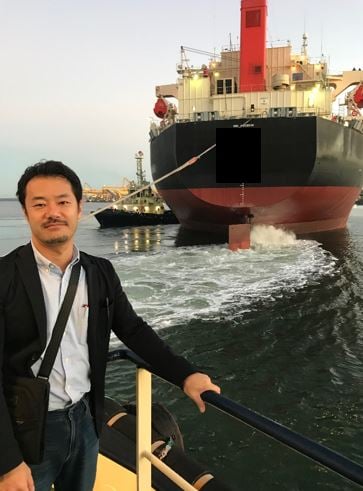
Hideyuki Irisawa
MOL Shipping(Australia) Pty. Ltd Managing Director
Joined the company mid-career in 2005, moving from the IT industry. Worked in iron ore/coal/wood chip transportation, group company management, and real estate business before moving to Sydney. Currently working on visiting ports scattered across Australia, managing local subsidiaries, building networks with federal/state governments and private companies, and developing new businesses. His wide-ranging work experience in the past has stood him in good stead in his work activities. He has enjoyed watching rugby, surfing, and skiing since school days, and Australia gives him many opportunities to indulge these pursuits.
View of incoming ship from a tug boat at Newcastle, the world's largest coal port.
Recommended Articles
2022.07.05
- General Shipping
2021.04.13
- Energy
2023.12.19
- General Shipping
2021.08.07
- Eco Friendly
2025.03.18
- General Shipping
Latest Articles
2025.12.09
- Eco Friendly
- General Shipping
2025.12.03
- General Shipping
2025.11.20
- Energy
- General Shipping
